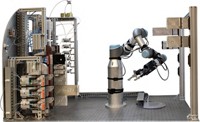Advertisement
Grab your lab coat. Let's get started
Welcome!
Welcome!
Create an account below to get 6 C&EN articles per month, receive newsletters and more - all free.
It seems this is your first time logging in online. Please enter the following information to continue.
As an ACS member you automatically get access to this site. All we need is few more details to create your reading experience.
Not you? Sign in with a different account.
Not you? Sign in with a different account.
ERROR 1
ERROR 1
ERROR 2
ERROR 2
ERROR 2
ERROR 2
ERROR 2
Password and Confirm password must match.
If you have an ACS member number, please enter it here so we can link this account to your membership. (optional)
ERROR 2
ACS values your privacy. By submitting your information, you are gaining access to C&EN and subscribing to our weekly newsletter. We use the information you provide to make your reading experience better, and we will never sell your data to third party members.
Origins Of Life
Computational model uncovers possible prebiotic syntheses
A computer-generated network maps new routes from simple starting materials to biomolecules
by Ariana Remmel
September 24, 2020
| A version of this story appeared in
Volume 98, Issue 37

It’s hard to investigate the origins of life without having a good idea of what chemical building blocks would have been available. Now, a research team led by Bartosz Grzybowski and Sara Szymkuć have created a software called Allchemy that generate networks of potential prebiotic molecules from a handful of simple starting materials (Science 2020, DOI: 10.1126/science.aaw1955). The network shows that complex chemistry could have emerged from a basic set of small molecules that were present on early Earth.
To create the software, the team started with what chemists know about the prebiotic syntheses that were likely possible on our planet before life emerged. Then they fed the program six simple starting materials that were present on early Earth—methane, ammonia, water, hydrogen cyanide, nitrogen gas, and hydrogen sulfide.
Allchemy applied the reaction rules iteratively to create successive generations of reaction products connected by a proposed synthetic route. This created a network of hundreds of potential prebiotic molecules including many biomolecules such as citric acid and uric acid.
Szymkuć, a computational organic chemist at Allchemy was excited by the emergence of new chemistry with each iteration of the program. Over time, “new reactions become possible that generate more and more diversity,” she says. This shows potential pathways by which prebiotic chemistry could have become more complex, leading to the emergence of life as new reactions generated increasingly diverse materials.
In addition to “rediscovering” the synthesis of biomolecules previously described in the literature, the network also suggested prebiotic preparations that had not yet been simulated in the wet lab. The team validated the computer’s predictions by carrying out new prebiotic syntheses of molecules including citric acid, diglycine, and uric acid.
The software also proposed molecular cycles, which are circular synthetic routes that regenerate the same molecules in sequence. Biology uses cycles like these to sustain metabolism with processes like the Krebs cycle. In one example, a proposed self-regenerating synthesis of iminodiacetic acid was confirmed in the lab with 126% recovery of the starting material over a multistep synthesis. Grzybowski, a physical organic chemist at the Institute for Basic Science in South Korea, hopes that their Allchemy network, which is publicly available, will help scientists find even more potential prebiotic cycles.
The software provides insights that are difficult for human chemists to see, says Wilhelm Huck, a systems chemist at Radboud University in the Netherlands. But he says Allchemy is limited because it does not include kinetic data for all reactions. This key information is often not available in the literature that’s used to feed the software. “If you want to go from molecules to life, then at some point the reactions need to create some function, and function will often be selected based on kinetics,” he says.
The research team is currently working to increase the computing power of the system to create more robust networks to explore. Though he agrees the lack of kinetics is a limitation, Grzybowski hopes Allchemy will show how computers can help in the search for the orgins of life.
Correction
This story was updated on Sept. 29, 2020, to correct the spelling of the main researcher's name, Bartosz Grzybowski.





Join the conversation
Contact the reporter
Submit a Letter to the Editor for publication
Engage with us on Twitter